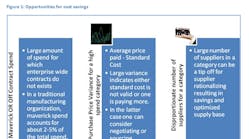Identifying Savings Opportunity in Your Procurement Path
The importance of purchasing in any firm is largely determined by four factors: availability of materials, absolute dollar volume of purchases, percent of product cost represented by materials, and the types of materials purchased.
Most procurement departments have a good understanding of the most critical categories of goods and services that their organization buys -- the direct materials, subcontracted services, and other things that are close to the core of what the organization is in business to do. Having such knowledge, illuminates the procurement departments regarding what they buy, how much they buy, who they buy from, and what fair market pricing is. This understanding enables these procurement departments to manage these critical categories well, achieving respectable cost savings and getting good supplier performance. The Pareto's 20:80 rule however does not apply here since these critical categories only represent a small portion of the organization's overall spend (fraction of the line items purchased in a given year). Also, they only represent a minor percentage of the cost savings opportunities that the organization achieves in comparison to the actual potential.
Majority of the cost savings opportunities are hidden in the rest of the categories of goods and services that the organization buys. Because these categories have less visibility within the organization, they have been historically undermanaged, characterized by the use of too many suppliers and are bought at higher than benchmark prices.
Identifying these hidden opportunities is not very difficult. This article shall look at a 5 step process that helps organizations identify as well act upon the opportunities in these categories.
The 5 steps are:
- Mine procurement information
- Transform the procurement information
- Identify sourcing opportunities
- Execute sourcing opportunities identified
- Calculate your savings
Step 1 -- Mine Procurement Information
Most organizations have some sort of electronic system in place for managing their purchase orders and supplier invoices. The data can be retrieved and used for identifying opportunities. Though the process sounds simple, the ground reality is that the quality of data mined from procurement and purchasing systems can at many times be difficult to comprehend. The poor quality can be in terms of nomenclature, material coding and at times even item description. Thus, availability of data will be of minimal use unless it is classified uniformly.
Step 2 -- Transform the Procurement Information
Once the data is mined, it's time to derive value by converting this raw, almost unusable data into actionable information that can be utilized to streamline your processes. There are several pieces of information you need from each record in the database: a clear description of what you've bought, a correct category, and the supplier. It often happens that a laptop is categorized under Office Supplies at one location and under mainframe purchases under another. Such disparities arise due to inaccurate categorization and different people involved in the data entry process. The same discrepancies can arise from entering vendor details resulting in one thinking of having more suppliers than what one actually has.
All of these very common errors can provide the procurement professional with data that is either less than adequate for a good sourcing initiative or, in the worst case, not usable at all. While the adage "garbage in, garbage out" held true and crippled many sourcing plans, there is a way to transform that "garbage" into more accurate information. That's called data cleansing. Adopting a uniform code like UNSPSC can be a very good start to making your data actionable.
Step 3 -- Identify Opportunities
Once you have clean data, you are able to conduct a meaningful spend analysis. Simplified, spend analysis is the systematic review of historical purchase data. The output of spend analysis is a summary of purchases by various variables, such as category, supplier, and/or business unit.
The primary reason for conducting spend analysis is to identify opportunities for cost savings. The output for spend analysis is the identification of opportunities for cost savings. These can be classified in the following ways;
Figure 1: Opportunities for cost savings
Step 4 -- Execute on the Identified Opportunities
Once you've analyzed your spend and identified the categories to target for cost savings, the next step is to prioritize those opportunities and conduct sourcing initiatives for each.
The Easy Savings Categories: When launching a new process, starting with little risk and gradually accepting more is wise. So begin your strategic sourcing initiative with a category where success is easier to achieve. Simple categories like office supplies where several competent suppliers compete against each other with fervor may be the first place to look for easy savings.
Non-Traditional Categories: These areas include health benefits, advertising, travel, and fleet services. Identifying these areas and learning to work with your new internal customers is a challenge by itself. Some of these categories will require careful consideration and a very cautious, deliberate approach to supplier selection. But some of the categories will be a bit more straightforward. These more straightforward categories will enable you to use e-Sourcing, which has been a proven way of achieving higher degrees of cost savings compared to traditional competitive bidding. An e-Sourcing tool can provide benefits at each stage of the sourcing process;
- Sourcing planning
- Event creation
- Supplier Evaluation and Award scenarios
An e-sourcing solution helps to reduce the time to source, reduces complexity in your sourcing process and increases the potential to generate savings from your current process. An e-sourcing application seamlessly integrated into a Spend Analysis solution can be a great enabler to realize maximum value from your Spend Data.
Step 5 -- Savings Calculations
Traditionally, cost savings is calculated by subtracting the new price from the baseline price and multiplying that difference by the current year's estimated quantity. Generally, that's a good starting point for estimating your cost savings. However, there are some potential adjustments you may want to make to your cost savings numbers.
Here are just a few:
- Provide savings calculations which are accurate and actual rather than providing estimates and predictions.
- Second, be careful in how you claim cost savings when quantities change from year-to-year. If your quantities are increasing by 50% from last year to this year while price goes down by 5% that means you are still buying more than last year. Change in quantity should be compromised with the change in prices negotiated to report actual savings.
- Calculate savings on a year-on-year basis comparing average prices from the previous year with that of the current year and state the quantum of savings.
Conclusion
Well, as you can see, it is possible for a procurement department to identify and act on cost savings opportunities, even when the starting point involves very bad data. While many people in the procurement field would consider overcoming the lack of data to be a gargantuan task, with five structured steps, you can deliver some real results. And the best part is, none of this involves tediously long processes or resource investments. The primary enabler for all the steps here is the data that your organization will already possess. All that needs to be done is the establishment of the correct processes to ensure realization of these savings potential.
James Thomas is part of the Product marketing and Strategy team at Zycus Inc. Zycus provides global spend management solutions to more than 200 leading Fortune 1000 customers.




